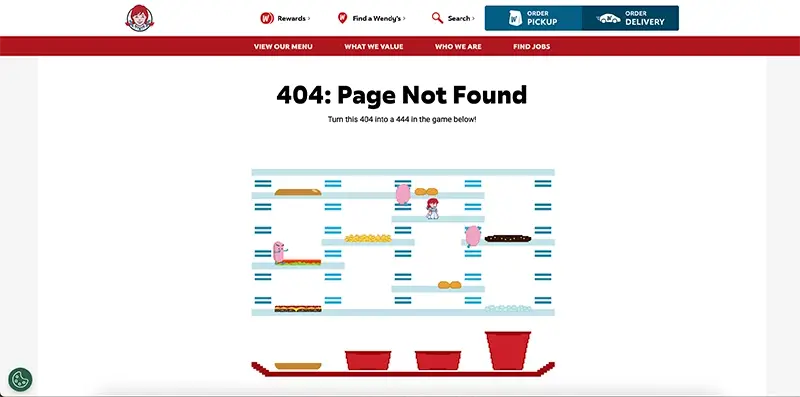
A 404 error page is something no website visitor wants to see – but that doesn’t mean it has to be a dead end. Instead of a generic “Page Not Found” message, a well-designed and creative 404 page can keep visitors engaged, entertain them, and should guide them back to relevant content. The best 404 pages turn an unfortunate moment into an opportunity to reinforce brand personality and user experience.
Here are some examples of creative 404 pages we love:

American fast food chain Wendys turns an error into a game. Help Wendy make her orders in time by directing her around your screen towards the ingredients whilst avoiding the pink blobs trying to get you.

If you’re into classic computer games, you’ll love hosting and domain provider Kualo’s 404 page, which allows users to take out their error frustrations on space invaders.

Vev allows users to get their creative juices flowing by offering them a blank canvas to doodle on.

Whilst very similar to Vev’s drawing canvas, Left Logic also include a gallery of previous favourite 404 visitor artworks inspiring a hint of competition in users.

Mad allows users to “doodle” using an entire screen of toggle buttons.

It’s not just doodlers being given the opportunity to get creative, RCA Records offers users the chance to make music.
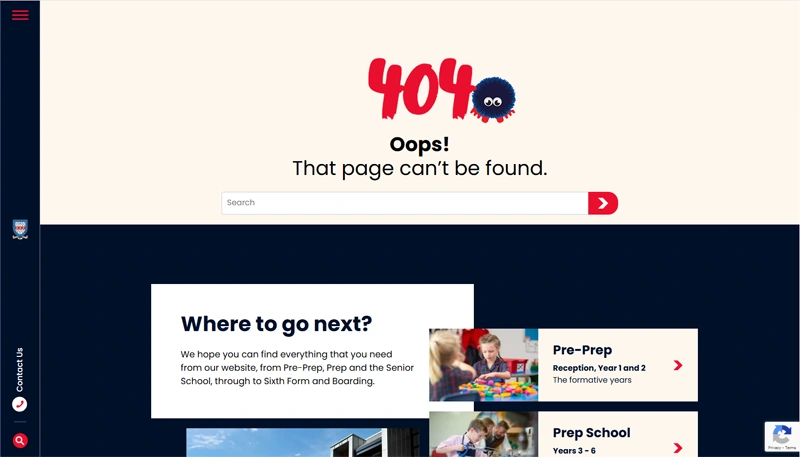
OK, so we’re a little bias with this one, as we created this page. A little animated version of their Woody character rolls in and out of the page. A site search and some key page links means people can navigate to something more useful.
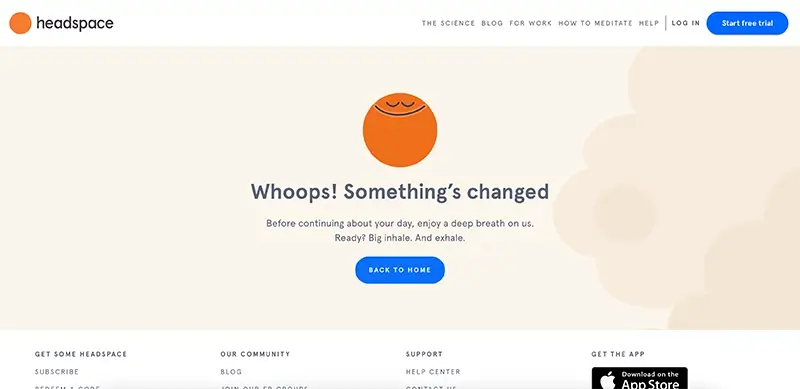
Headspace keep it on brand by inviting users to take their 404 accident as an opportunity to stop, and take a deep breath.

Lego keep it lighthearted with star of the Lego Movie, Emmet, on their 404 page.

Marvel use a variety of different recognisable characters to convey their message.
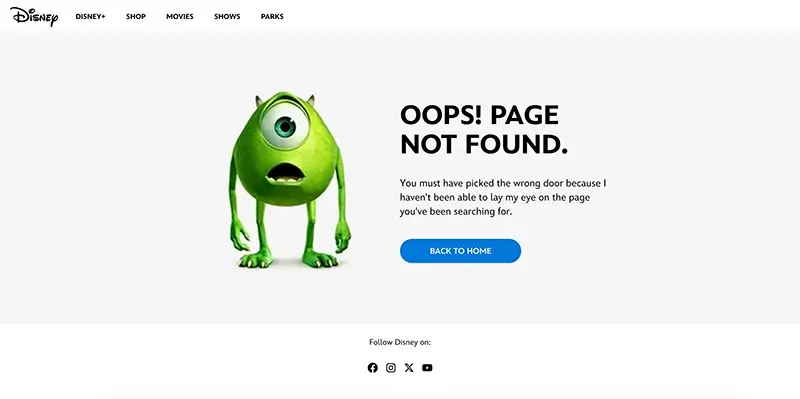
Disney also use a recognisable character in their more light hearted style.

Pixar follow suit, with an image of a recognisable character and also use that characters tone of voice for their messaging.
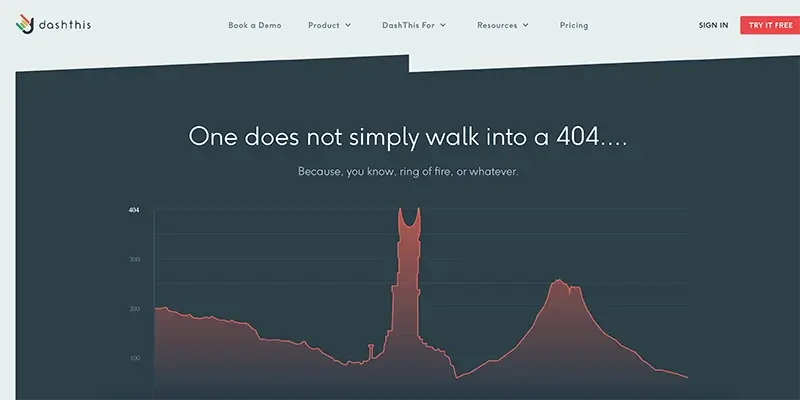
Dasthis appeal to Lord of the Rings fans with a witty reference to Mordor.
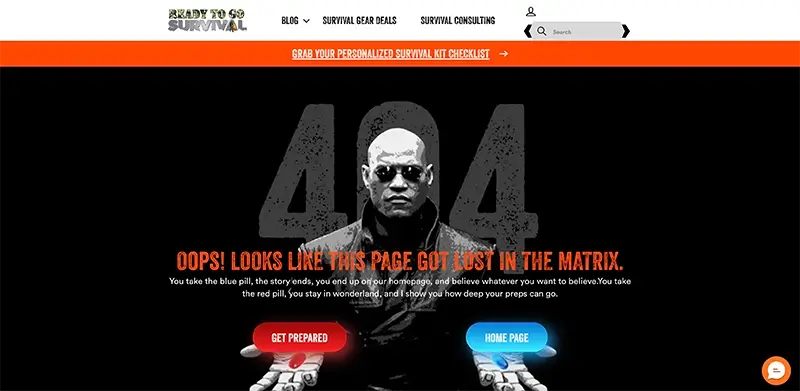
Whilst Ready to go Survival gives users a choice of where they want to go next, comparing it to Neo’s choice in the Matrix.
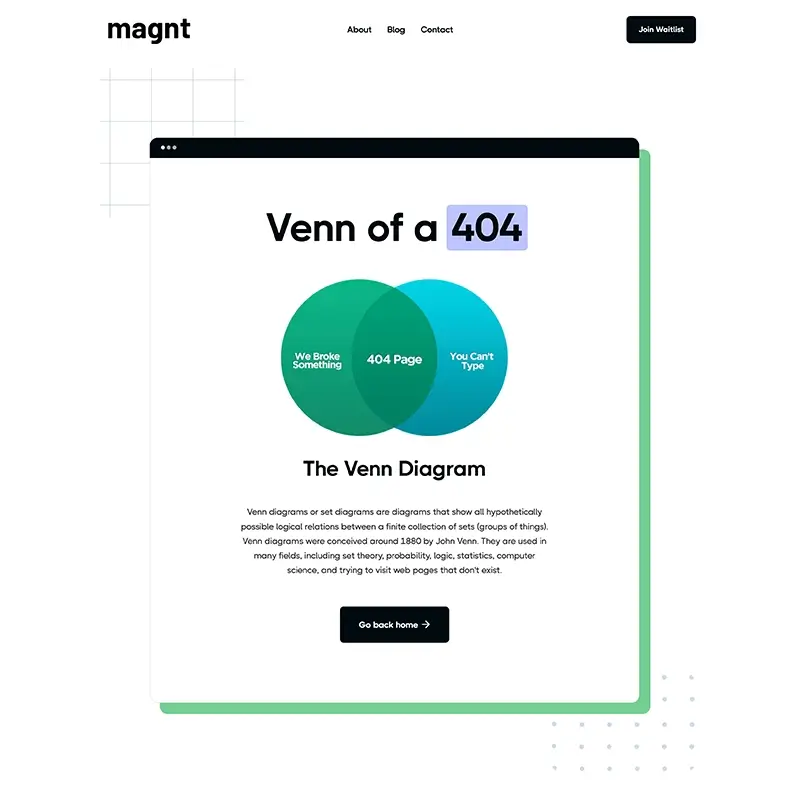
Magnt poke fun at users spelling ability with their venn diagram 404 page.
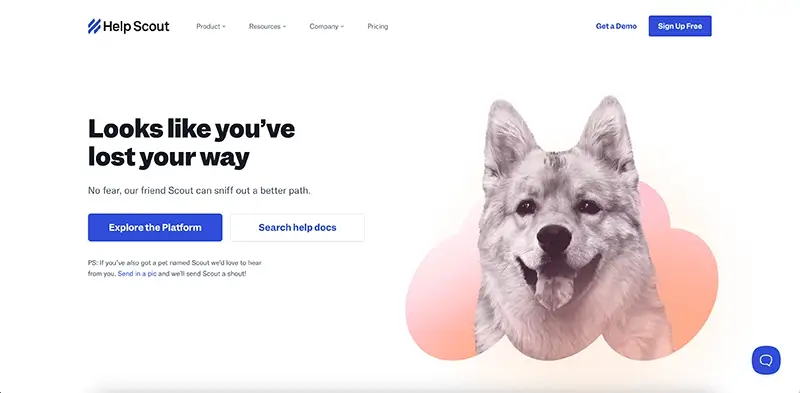
Help scout makes any frustration a user might have felt at their 404 error melt away with their adorable “friend” Scout.
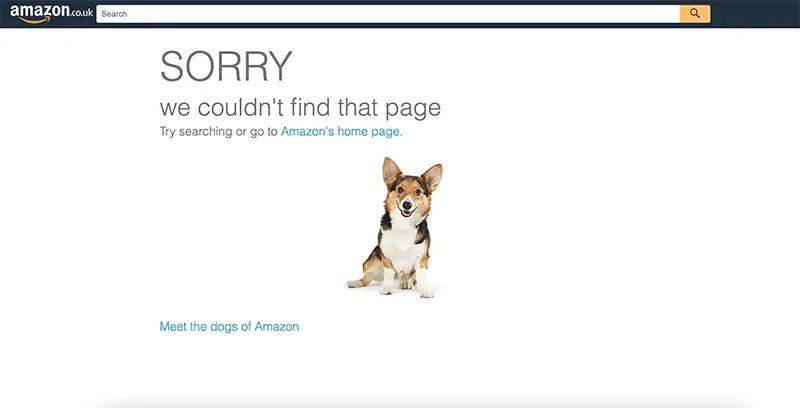
Whilst Amazon seem to have a whole army of different happy pups at their disposal to cheer up frustrated users.

Things get really weird (and wonderful) with Kffein’s 404 page. There’s really no way to explain – you just have to go there yourself…

Self proclaimed as “The most awkward 404 page on the internet” Steve Lamberts way of dealing with an awkward error is to just make things even more uncomfortable with his on page video. Maybe not a choice most people would want on their website – but it’s certainly different.
There are a few really easy tips to avoid visitors seeing too many 404s on your own site:

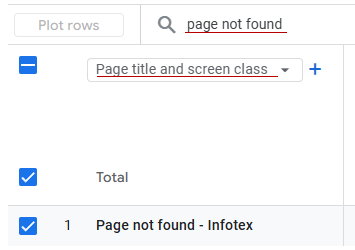
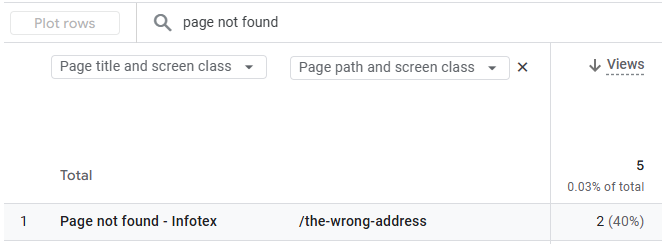
As the days start to lengthen and it feels like we’re edging out of winter we all look forward to the new life and freshness of spring. Does your website feel the same or is this a good opportunity for a bit of housekeeping to make it spring fresh and ready for the summer?

It is natural in business that staff will periodically move on, either to other roles within your business or elsewhere.
When did you last review the list of users with access to your website’s administration area to ensure that only staff with a current business need have access?
Leaving accounts active for staff no longer employed can lead to severe problems, The British Museum recently had a disgruntled ex-contractor return and use their, still active, access to shut down a number of exhibits ahead of a busy weekend. If their access been revoked promptly they would not have been able to do so. For e-commerce sites you also have a duty of care to the personal data of your customers, per the GDPR legislation.
For WordPress sites, this is as simple as viewing the Users list in the admin and checking that all those under the Administrator, Shop Manager or Editor tabs still need access, and revoking or deleting any who are no longer needed.
From a security point of view you should avoid sharing logins and each staff member should have their own username and unique password for each site.

When did you last change the password for your website admin? Could anyone else know what that password is or is it even in use elsewhere? It is good practice to rotate (i.e. re-generate) passwords periodically to avoid any old record of it escaping your control. Most importantly, ensure that any password you choose is strong and unique, i.e. never re-use the same password on more than one site. Most good password managers have a password generator and if you’re not using a password manager (why not?) then you can still generate a really good password using online tools – WordPress has a strong password generator built in for example.
If you don’t already have 2-factor authentication enabled you may wish to add that to keep your borders fortified.
Websites evolve over time, is yours still showing outdated features or content? Are there still references to COVID-19 precautions or does your contact form still ask for a fax number? All of these things can make your website seem dated and potentially lose business. In some cases, you may even find you have features, and plugins for those, which are no longer relevant and removing these would free up space for more valuable content. Removing redundant plugin(s) can also speed up your website and even make it more secure and easier to manage going forward.
Perhaps it’s time for your website to grow a new feature, some aspect of your business that isn’t already available or something that would make your life easier, it could be anything from a listing of clearance items, a newsletter sign-up form or even a customer management system to allow you to run your business more effectively?

Do you send out newsletters to your customers regularly, if so when did you last check on your bounce rate and interactions, do you need to remove old recipients who’ve not engaged for years (or try to re-engage them), are there new active customers who you’re not sending to that might appreciate your newsletters, is your template on-brand and fitting with your website or a relic from previous seasons?

Are you still running Google Ads campaigns using the same words & phrases as last year? The world moves on and so must your choice of terms to remain relevant and cost-effective rather than old and dusty.
With so many changes to online advertising is your website using the latest types of campaign to get the best conversion rates and lowest cost per lead? Are your landing pages fresh and inviting? A Digital Marketing review might be what you need to clean up your marketing efforts.

Ok, don’t try putting emulsion on your monitor, however your website’s design does age, is yours looking from the last decade? If so it might be time to speak to our designers about adding a bit of pizzazz back into things, and perhaps take that one step further with a full user experience review so that it is spring-fresh, sparkling and doing all it can to drive your business forward.
Gen Z (born 1997-2012) are known as the first true digital natives who have grown up with the internet, having easy access to social media, portable digital devices, smartphones, tablets as part of everyday life. They are tech savvy and highly adept with online digital tools and platforms whose preferred way to communicate is via online messaging through social media, gaming platforms and smartphone apps.
Generation Z has distinct digital behaviours compared to millennials, Gen X and boomers. Due to growing up in a digital online world they have had instant access to information to meet their particular needs preferring short form video engaging interactive content which is easier to digest rather than long form text.
Millenials grew up in the time period of making the transition from analogue to digital devices. Gen Z prefer mobile to desktop having had access to smartphones and portable devices.

There is a trend of Gen Z moving away from Google to using social media for searching for information and discovering new brands.
In a recent study when asked where they most frequently discover new products, 18- to 27-year-old consumers responded with:
This data highlights the growing shift toward social media platforms for product discovery among Gen Z.
However, don’t be fooled as Google isn’t going away anytime soon. Millennials (42.45%), Gen X (41.1%), and Boomers (55.9%) still rely on a Google Search first.
As traditional search marketing and AI evolve brands need to leverage social platforms, embrace authentic marketing, and prioritize experiential content to thrive with Gen Z.
I have always felt that a lot of business software development misses a very important part: a structured and formal approach to the business rules and requirements of the developed system (the business Domain). I have always felt that there was never really a home for it, or at least I was not sure where it should go; front-end developers tend to mix it with interface concerns, database experts tend to put it in the database, and newcomers have no idea where to put it. As more requirements and features are added to the same code base over time, what we end up with is an unmanageable and confusing mess, often referred to as a big ball of mud.
This approach to software development will introduce errors because it is difficult or impossible to properly test. It degrades developer productivity because bugs are very hard to pin down even when their results can be observed, because it is not obvious where to look. Any added functionality will create an even bigger ball of mud as there is no incentive to not do so. Eventually the software solution becomes unmanageable.

Where appropriate, we follow a Domain Driven Design approach. The Domain components of the solution model the processes and requirements of the actual real-world business processes and requirements. This is done in focused and specific modules that relate to a particular business context – in this way, each module focuses on a specific aspect of the overall solution and does not try and do too much.
These models contain both properties – the current state of the model, and methods – the ability to change the model state through actions. The state of the model should not be externally editable except through these methods and should never become invalid – if an attempt is made to change the model into an invalid state (through a method) that change should fail with the reason. In this way we enforce the business rules of the application.
This works well, and I believe this is especially important for business software, as, often, the requirements will contain lots of complicated business logic, rules and invariants and perhaps state-mandated regulations like GDPR. By attempting to distil this into a single, well-defined layer of the application, it becomes easier to test, easier to maintain and much easier to reason about. Additionally, because the domain model components resist becoming invalid, it should be much more robust and more difficult to break (either intentionally or by accident).
We can then build on and out from the domain components, adding database access and external services, and expose the domain to any software systems that require its services.
There is no such thing as a free lunch – on the flip side, this highly structured software engineering takes much more discipline and consideration. It also requires belief and confidence in the process from all involved and therefore can increase the time and effort it takes to initially deliver the system.
In our 25+ year history we have moved our headquarters several times to meet the changing needs of the business. From a smaller ground floor office to a much larger two floored premises as our team and client needs grew. However, despite relocating we’ve always remained true to our roots, basing ourselves within the Woodbridge area. The town has recently been voted the happiest place to live in Britain and our loyalty and connection to the local area certainly attests to that.

Like many organisations during Covid, we closed our office and decided to be entirely remote based, giving us time to take stock and see how the post-covid world would unfold. During this time we were fortunate enough to have use of the fantastic facilities at Martley Hall and Riduna Park, enabling us to still have face to face meetings and work together in person when the need arose.
Fast forward to 2024 and we felt it was time to have our own base once again, having established a new routine and way of working we needed a smaller premises to offer hybrid working, a place to host client meetings and our company-wide gatherings.

We found this and more at our new premises on TideMill Way, less than 5 minutes walk from the train station and Woodbridge town centre. With stunning views of the River Deben, fab coffee from Suffolk Coffee Pod and relaxing walks right on our doorstep to get the creativity flowing. Our new home feels like we’re in a holiday destination rather than an average office block – arguably our best office yet!

Towards the end of each year the audio streaming platform Spotify releases its Spotify Wrapped data analysis. Whilst at first glance it provides an individual user with certain claims to fame and insights on the way they’ve listened to music or podcasts that year, it also highlights the sheer volume of information that Spotify have recorded in their data platform.
In an article published in April 2024 Spotify stated that they are processing 1.4 trillion data points every day. Those would include plays of particular tracks or podcasts, subscriptions to podcasts, likes of tracks and even searches for a particular song or artist. Spotify have built their own bespoke data platform to support this volume of activity because the insights it gives into how users interact with their product helps them to further enhance their service.

Spotify are very open about the way they record, store and analyse the data they collect with their engineering team having their own website at engineering.atspotify.com where they post information about their use of data. Each of those 1.4 trillion data points is recorded in their event delivery infrastructure which feeds into the data platform where the data is processed and stored. Spotify is an extremely data-driven organisation, they use the data platform to report on their own key performance indicators and to improve their product whilst also making it available to users through in app recommendations and in the more fun Spotify Wrapped.
Let’s look at a few insights from members of the Infotex team in their 2024 Spotify Wrapped. One person found themselves in the top 0.001% of users listening to a particular track – achieved by listening to it 166 times.

Not all songs required a high number of listens to get into the top listeners category. It only took 3 listens to get into the top 0.5% of listeners of this Weezer track.

One Oasis fan found themselves in the top 0.5% of listeners for that band this year, kick started after their reunion tour announcement.

This year Spotify have decided to theme some of their insights, one user found their October listening described as a Heist Happy Rock Britpop month:

If you want to see the most popular artists, songs, albums, audiobooks and podcasts across the world you can visit Spotify’s Newsroom for the details.
Spreadsheet Day was created as a way of celebrating one of the most widely used computer-based tools and this year marks both the 15th occurrence of Spreadsheet Day and the 45th birthday of the spreadsheet itself. October 17th was selected because on that day in 1979 VisiCalc, the first spreadsheet program, was released for the Apple II computer.

Over the last 45 years, spreadsheets have proved their versatility and importance to both business and personal users. In today’s data-driven world spreadsheets help businesses to understand more about their operations and can be used to forecast future trends. Their ability to store formulas which can recalculate automatically means it is easy to produce complex calculations and then update values to see the impact in real time. Most spreadsheet tools now also include charts and graphs allowing us to visualise data rather than focus purely on the numbers.
The Infotex team have been discussing some of their favourite spreadsheet functionality. Built-in functions feature highly on the list with the VLOOKUP function a particular favourite. VLOOKUP allows you to search through a dataset for a value and then return another cell from the matching row. Honourable mentions go to the CONCATENATE function (or CONCAT in newer versions of Excel) allowing you to join together text either from referenced cells on the spreadsheet or text that you specify and DATEDIF which allows you to work out the number of years, months or days between two dates.

While Microsoft Excel may dominate the desktop market, with the comparatively recent dawn of cloud-based spreadsheets like Google Sheets the ability to collaborate with colleagues has grown massively with the ability to see real time updates made by collaborators from anywhere in the world. Google Sheets has some impressive functions of its own including IMPORTXML which can retrieve values from a webpage based on HTML tags.
Whilst we’re celebrating spreadsheets we also have to keep in mind times when they’ve been put to uses that maybe they weren’t originally intended for. One infamous example is during the early days of the Covid pandemic the use of an old Excel file format meant that records of test results were incomplete because the spreadsheet simply ran out of rows. More recently a “spreadsheet issue” was blamed for 6,500 votes being missed from the originally declared votes for the Putney constituency in the 2024 General Election (although the oversight didn’t change the overall winner).
Last year we looked at what to do if your spreadsheet has become unmanageable so if you find yourself with a spreadsheet that is stretching the limits of what they are capable of then do consider getting in touch to see how we can help out.
Once again the Infotex team laced up their running shoes for our annual fundraiser this time in support of AYC Schools Sailing Trust, giving schools in Suffolk an opportunity for their students to get on the water and benefit from the life skills that sailing and water-based sports can encourage – creativity, confidence, teamwork, communication, determination, and independence.

Having personally participated in the event for the previous three years (2x Whole Hogs, 1x Boss Hog), I was once again part of an 8-strong team of Infotex employees, friends and family who embarked on the dirty delight of a mud race. Five of whom opted to join me in the step up to the Boss Hog, an extra 2 miles and 10 obstacles of filthy fun on top of the standard 5-mile route.
As someone who does neither enjoy running nor getting dirty, the Whole Hog always comes around with apprehension in mind. Whether that may be in fear of the long course ahead or in competition with myself to better the previous year’s efforts, which I’d been able to do each time before. So this year I, like several other of my teammates, took the more relaxed approach, with the aim being to get around the course in one piece and most of all, to enjoy it!

Like with any Whole Hog, the event itself was immaculately organised from the moment we arrived, warm, dry and full of optimism. To the after race clean up, wet, filthy but full of pride!
At the beginning of the day, you arrive to a sense of anticipation and joy amongst the crowds that have already gathered, some of whom are about to embark on the day’s opening wave of the race (1 of 4), whereas others are just clocking in for one of the later start times. The Suffolk Gen X radio booth booming with motivational anthems and volunteer staff as enthusiastic as ever to both encourage and make fun of their muddy guinea pigs.
As is now tradition we set off at 10.30am as part of the second wave of runners, initially sticking together within the middle of the pack whilst we navigated our way through the opening mile of ups, downs and if I didn’t mention it… Mud!!!

Eventually, the pack naturally split with myself and Honey running as a duo and an awesome foursome of Ant, Chloe, Fred and Theo working through the mud as one… It doesn’t take a mathematician to work out that between those packs we’re still two short, and as with previous years the competitive spirit had leapfrogged the aforementioned ‘relaxed approach’ resulting in both Shaun Bailey and Marathon-runner Ollie galloping off individually into the distance.
Shaun and Ant, who had opted for the 5-mile Whole Hog route, crossed the line in fantastic times of exactly 1 hour and 1 hour 25 mins respectively. Whereas the Boss Hoggers were of course led by Ollie, finishing the 7-mile course in an amazing 1 hour 11 mins, equating to 3rd place out of 646 runners across all four waves in the event. Myself and Honey followed at 1 hour 35 mins, with the remaining trio (abandoned by Ant at the Whole Hog/Boss Hog intersection) of Chloe, Fred and Theo finishing in a superb 1 hour 56 mins.

The day once again proved a huge success, full of mud, sweat and well-spirited jeers! So our thanks once again go out to the Whole Hog organisers and their brilliant volunteers for another great event.
If you would like to support our team’s efforts, there is still time to donate to the AYC Schools Sailing Trust. All contributions are greatly received and will go a long way in helping young students learn important life skills.

While some of the hype around AI seems to be slowing from its lofty peaks of 2023, many are finding the real-world practical applications for the technology. For those with ecommerce websites AI can significantly enhance the performance, efficiency, and user experience for visitors.
One of the obvious early benefits for users of the likes of ChatGPT was for its ability to generate content quickly. Inputting some bullet points and asking it to create product descriptions or SEO’d page titles prevented the horrible feeling of staring at a blank page waiting for inspiration.
That idea has now been built-in to the Shopify platform, where AI can be used to help write product descriptions from a basic prompt. For product images, Shopify have also introduced the ability to to transform backgrounds to showcase your product in multiple locations based on your prompt.
Popular SEO WordPress plugin YOAST has AI-powered suggestions for meta descriptions in the paid version of the add-on.
Artificial Intelligence can analyse the user data of people accessing your site helping you to find and retain customers. One of the more involved ways of using AI in ecom is to personalise a user’s shopping experience. Further than just a “welcome back” message or a generic “you may also like”, these tools analyse user behaviour based on past purchases and site browsing history to provided targeted and individually personalised product recommendations. BloomReach’s system allows for custom banners and targeted discounts moving away from site-wide one-size fits all marketing messages.

One element in the sudden rise of AI was the improvement of natural language processing, which is how computers understand humans. Using NLP, AI can interpret the shopper’s query allowing you to more accurately understand their intent and deliver the search results they’re looking for. AI can also enhance search accuracy by adding synonyms, filling in missing words or phrases, and automatically correcting spelling errors. E.g. a search for “sneakers” could be substituted for a search for “trainers”.
As with site personalisation, a user’s on-site behaviour and purchase history can be used to aid with future intent, so when they do use the search on your site you can present items they may be more inclined to want. Klevu’s site search utililses machine learning and natural language processing for advanced configuration options.
Customer Services & Support
Chatbots have been around for a number of years, with many people suffering frustrating customer service encounters with them. However, some of the more modern bots can be almost undetectable from real humans for straightforward enquiries. Intercom.com’s Fin AI agent provides a live help service and pulls in information from across your website to make sure consumers get accurate answers.
Pricing
It takes a lot of time and research to know what to price your products in an ever-changing market. There are AI tools that can analyse market dynamics and competitor pricing to help you find the right price for your products. This can be coupled with other elements such as consumer demand and inventory levels for real-time dynamic pricing.
AI is transforming e-commerce, offering tools that can improve customer experience, personalization, search functionality, and pricing strategies. Even if some tools don’t fit your needs now, staying updated on AI trends ensures you’re ready to adapt and stay competitive as the technology evolves. Monitoring these trends can help you spot new opportunities, streamline operations, and future-proof your business in an ever-changing market.
Since the inception of the Suffolk and North East Essex ICS Can Do Health & Care Expo in 2022, Infotex team members have attended as delegates but this year we had our own stand for the first time. The Expo is a great event bringing together a multitude of organisations who work together to improve the health and wellbeing of people across Suffolk and North East Essex. As a digital technology company we feel we can contribute by helping organisations improve awareness of, and access to, their services and introduce systems to streamline their processes to help them help more people.
We enjoyed the day and had some good conversations with the visitors to the Expo. We also took the time to visit some of the other stands to see and hear what other organisations are doing, it’s great to be able to find out more about what is going on in the local area.
Earlier this summer I had the opportunity to join our friends from Allied Health Professionals Suffolk CIC (AHP Suffolk) on their stand at the NHS ConfedExpo in Manchester. The expo is a two-day event where suppliers can advertise their products to an audience of NHS professionals and it also features a range of presentations about technological and process advancements within the health sector.
AHP Suffolk were there to promote their URefer self-referral platform for which the Infotex Systems team are proud to be their development partner. The URefer stand was shoulder to shoulder with stands from the likes of Adobe, BT, Google and Microsoft all of whom value the relationships they have with NHS customers and were keen to show off their range of products and services.
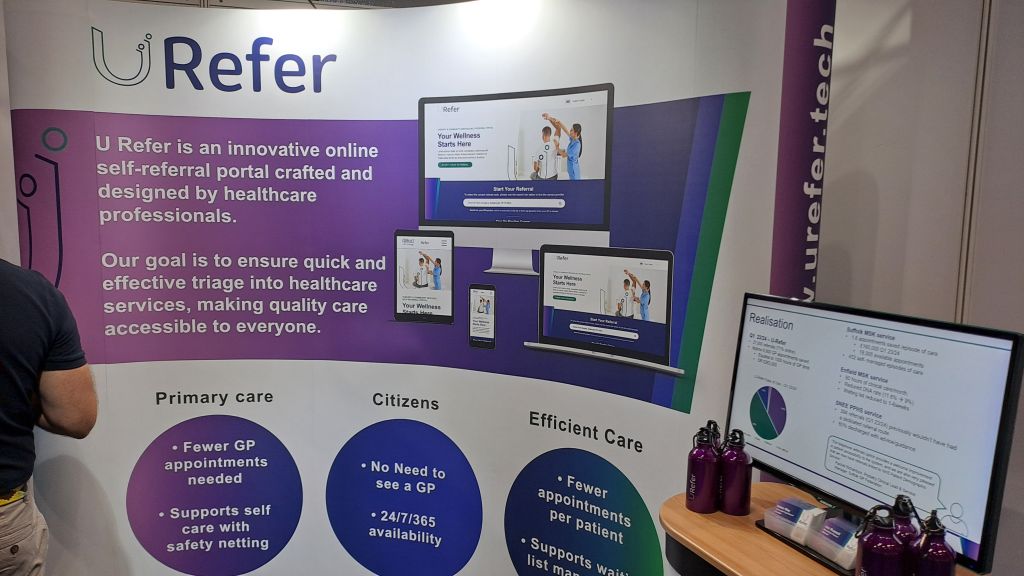
Over the course of the two days of the show it was interesting to see the enthusiasm for URefer amongst a variety of different organisations and over time more will be able to use the system to help patients to access the services they need easily.
As well as helping AHP Suffolk to promote URefer I also found time to browse the other stands myself, meeting up with some familiar faces from my time working in the NHS, looking at some of the new technologies companies were showcasing and listening to sessions being held in the various presentation theatres. Among those was a presentation by another Infotex Systems customer, Ian Turner OBE. Ian was there in his capacity as Co-Chair of the National Care Association to facilitate a talk entitled “Improving the health of care home residents through virtual care” based on processes being implemented in some care homes in the north of England.
All in all, it was great to see the local focus of the Can Do Health & Care Expo in person having also experienced the national level at the NHS ConfedExpo.

There‘s an increasing national debate about our children’s mental health and the impact of digital – especially smartphones and social media – on their development. I read more and more articles about this topic, and find I am having frequent conversations about it with people my age (our children are now adults, some of us are grandparents!), feeling we should do something. We are lucky enough to have grown up in happier times, with freedom to make a mess, and a mess of things. Being a bit bored, allowed to roam unmonitored, had its risks but it gave us resilience (and the opportunity to experience the highs that come after the lows!).
To quote Dame Rachel D’Souza, The Childrens Commissioner, “there is a growing group of children who are struggling with their mental health. This generation of children has experienced uniquely uncertain and challenging times. Some have spent some of their most formative years isolated and indoors ………… not all children have the support system and protective factors they need to thrive in these difficult circumstances.”
For me, this is also personal. I am not a complete stranger to depression and anxiety, and I am convinced that if I had not been blessed with opportunities to get outdoors (often reluctantly) and face physical challenges – hikes in mountains, jobs on farms, adventurous travel, and above all messing around in boats (sometimes called sailing), then I too might have fallen victim to mental illness, which can be so debilitating and blights so many lives.
With our small team in Infotex spanning a range of ages, and several parents in our midst, I have always been conscious of the need, in our techie world, for us to take care of our mental well being. I could have done a lot more, and been more systematic, but as we have ploughed and furrowed our way through the past 2 decades, some of them intense in their onlineness, to find ourselves in this post-Covid dystopian world of remote working and on-screen communication, we try to retain some contact with reality. We have had an Infotex golf club, a sailing club, an Ipswich Town Supporters club, and numerous “gatherings”, hack days and jollies, which have been a lot of fun and helped to keep us all grounded and connected to each other. As I write this, I realise we need to do more, and I must do something about that..
One of our traditions has been to take a team to run in the Suffolk Whole Hog – this is a ridiculous – but marvellous – annual event on a beautiful Suffolk farm, in which several hundred people with a diverse range of fitnesses, speeds and agilities all run together on a cross country course of several kilometres, dotted with hazards and obstacles.

Whilst there is a competitive spirit, and one or two of the Infotex team go at it hard, it’s the taking part that counts, and, in my case, as each year goes by it does get increasingly hard to get round in a respectable time. It certainly helps to have a purpose, so raising a bit of money for a good cause does force me out onto the circuit…
For me, messing about in boats has been the most consistent of my activities, and I do feel a certain passion for all it can provide. The pleasure is not just in the activity itself, but in having an awareness of the nautical aspect of any story, whether reading or watching videos. Even travelling on a cross channel ferry has an added interest, because you can look at the harbour and the other boats, interested in their course, speed and manoeuvres.
So this year I am really excited that on 6th October our team will be running the Whole Hog to raise funds for the the AYC Schools Sailing Trust – a wonderful small charity that gets young people from schools and youth groups out onto the water for a taste of adventure. The kind of adventure that I think sailing is uniquely brilliant for – creativity, confidence, teamwork, communication, determination, and independence. The Trust aims to offer young people in Suffolk the chance to learn to sail and to connect with the incredible beauty of Suffolk’s River Alde.

This summer 222 children came from 12 local schools, out of whom 3 children went on to do a full sailing course and crew in a proper race – so they are now sailors! Being outdoors, working as a team, learning about tide and the wind – every child that participates, even if for one day, gains something from this new experience whether it is learning to steer on their own, or conquering a fear of water. As a volunteer on the water, I was struck by how many of the children were completely unaware of Suffolk’s coast and rivers, and how positive this experience is for many of them.
There is plenty of scope to expand this to more schools – demand is outstripping supply and there is a waiting list. Despite an army of volunteers there are still costs. £50 pays for a child to participate in a training day, £500 is needed to pay for the transport for a school to get its young sailors to the water. We hope you will agree this is a very worthwhile project, which deserves to be supported, having as it does the potential to transform lives.
…and think of what I am putting myself through to try to attract your attention!]

Client Services Director Katie Robinson details her struggles in trying to buy 2024’s hottest tickets:
Instead of spending my Saturday morning having a relaxing breakfast with my family, I joined the millions of people across the country and around the world, trying to get tickets to Oasis.
Whilst I’m no stranger to the intensity of purchasing hotly anticipated tickets – indeed I have my own process and ‘proven method’ of success. This is the first time I have tried and failed.
Using multiple browsers and devices (with separate accounts) I found myself ‘queuing to join the queue’ just to access the TicketMaster website via my desktop.
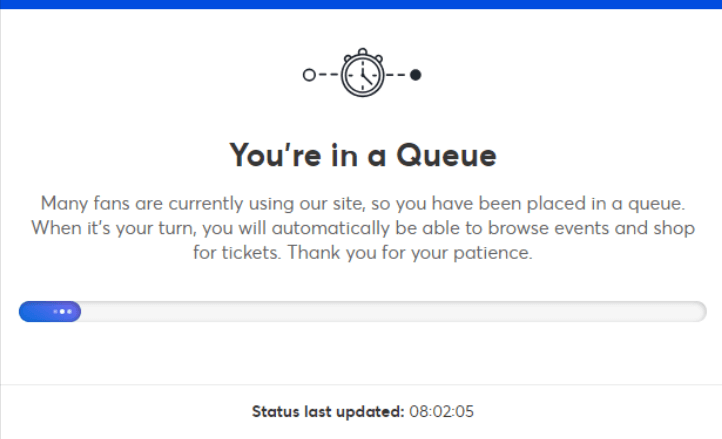
On my mobile I ran into various error screens, including being accused of being a ‘bot’ and pushed out. I eventually made it to the real ‘queue’ only to find that 300,000 other people had made it there before me. Even the distraction of housework didn’t make up for the sheer waste of time spent watching the number drop down as people gave up hope – indeed when lunchtime arrived, I too had given up.

Perhaps a different ticketing provider would work? Sadly not; Gigs & Tours kindly refreshed the screen for me, until it too gave up and ‘timed out’.
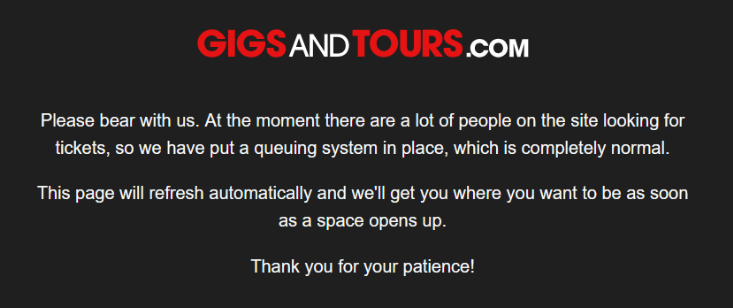
So, other than possibly getting carried away with the hype and losing hours of my Saturday, what have I learnt? Well, if all of the social media feeds are to be believed – then the ticketing providers ‘should have anticipated this’ and ‘have better systems’ in place. However, working in the world of websites and systems, I know that it’s really not that simple. The sheer level of demand on these servers and databases all at one time means that it’s almost impossible for them to cope with that amount of traffic and offer a seamless experience for everyone. Throw into that the intensity of human emotion (and human error) with the panic of frantically clicking buttons and inputting wrong details – it is a useful reminder that no system is without its flaws – even the really big ones.
Others in our team also spent their weekend glued to their screens, credit cards at the ready:
Kris Parker, Account Manager:
Before tickets had been issued there were questions over the presale application, as it required users to opt-in to marketing in order to qualify – something that isn’t allowed under GDPR legislation. This prompted the ICO to state “Our guidance is clear and we expect all organisations to comply with direct marketing rules. We have received a complaint about this issue and are looking into it.” This, combined with surge pricing and high ticket resale, have soured Oasis’ long-awaited return to live performing for many fans.
The demand for tickets shouldn’t have been that much of a surprise – Oasis’ Knebworth shows in 1996 had an estimated 2.5 million people looking to purchase the ¼ million tickets available. Back then you could buy them by phone or at one of 16 local box offices (which only accepted cash or cheque). You also got a real physical ticket, so maybe the internet hasn’t improved everything?
As an account and project manager, maybe I’ve got to crowbar in some lesson here about management of expectation or pre-planning or something that I can then stick on LinkedIn. Or, maybe I should have just logged on earlier to get tickets. Maybe they’ll extend the tour. Maybe they’ll split up before their first show. Maybe? Definitely.
Editor Note: Kris subsequently managed to be in a follow-up ballot, and had no issues purchasing tickets.

John Harman, Infrastructure Manager: We know that sites like Ticketmaster are no stranger to having large swells of traffic when new tickets are released, from a technical perspective the thought of architecting a system to handle over 1 million tickets being released concurrently where each can only be sold once and having millions of devices attempting to check which of those tickets are free simultaneously with each having multiple potential status’s is enough to cause a database administrator night sweats. Even aside their own system, there’s a multitude of dependencies such as payment & security providers who also need to be able to scale to accommodate. While there are tools to provide stress testing it would be almost impossible to design something to stress test the number of permutations which must have been going on in those servers on Saturday morning, no doubt there’s some engineers working out how to do that right now though, ready for whatever comes next.
Discover how our team can help you on your journey.
Talk to us today